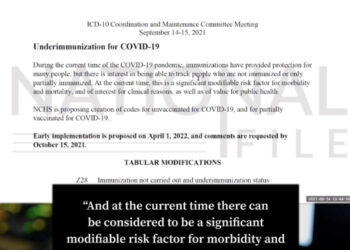Last Updated on December 1, 2020
A study critical to the narrative that COVID-19 is a deadly virus with the same killing power as smallpox or plague was published by John Hopkins University but was then suddenly retracted leading to this question. Why?
NOTE: Facebook is flagging this story as false information and removing it from feeds. Professor Briand continues to stand by her research.
On November 22, 2020, the John Hopkins University Newsletter published a study directly challenging the common narrative that COVID-19 a global threat to the human race.
Genevieve Briand, the assistant program director of the Applied Economics master’s degree program at Johns Hopkins University, analyzed the impact that COVID-19 had on US deaths saying the full impact of the virus – as it relates to deaths in the United States – can be understood by comparing it to the number of total deaths in the country.
According to the study – and contrary to the narrative being trumpeted by political opportunists and alarmists across the country, “[I]n contrast to most people’s assumptions, the number of deaths by COVID-19 is not alarming. In fact, it has relatively no effect on deaths in the United States.”
Utilizing data from the CDC website, Briand compiled a table demonstrating percentages of total deaths per age demographic from early February 2020 to early September 2020. This includes the date range from before COVID-19 was detected in the US to after infection rates “spiked.”
Remarkably, deaths among older people stayed the same before and after COVID-19. Since the virus primarily affects the elderly, experts anticipated an uptick in the percentage of deaths in older age groups. However, this increase is absent in the CDC data. In fact, the percentages of deaths across all age groups remains unchanged.
Here is a presentation by Genevieve Briand presenter of the paper that was reported on yesterday. Very important presention. https://t.co/oZjNqUa8yP
— Jeffrey A Tucker (@jeffreyatucker) November 26, 2020
“The reason we have a higher number of reported COVID-19 deaths among older individuals than younger individuals,” Briand said, “is simply because every day in the US older individuals die in higher numbers than younger individuals.”
“Every year in the US when we observe the seasonal ups and downs, we have an increase of deaths due to all causes,” Briand said.
Perhaps more interesting is the gerrymandering Briand found in how the death statistics were reported.
When Briand examined the 2020 data in context with the seasonal fluctuations, COVID-19-related deaths exceeded deaths from heart diseases, an unusual finding because heart disease always prevailed as the leading cause of deaths.
When a closer examination of the CD data was performed, Briand noticed something disturbing and unnatural.
Briand compared the number of deaths per cause during seasonal periods in 2020 to 2018, and in doing so noticed that instead of the usual drastic increase across all causes, there was a substantial decrease in deaths due to heart disease. Even more alarming was that this sudden drop in deaths is observed for all other causes.
“This trend is completely contrary to the pattern observed in all previous years…the total decrease in deaths by other causes almost exactly equals the increase in deaths by COVID-19,” the study reads.
Briand’s conclusion? The COVID-19 death toll in the United States is deceptive and that deaths from other diseases are being categorized as COVID-19 deaths.
When Marvis Gutierrez and Ariella Shua, the managing editors of the JHU newsletter, were asked about the study’s removal from the publication their excuse presented as unbelievable and shocking.
“The article in question was retracted last night, as it was being used to spread misinformation about the pandemic…We were not censored, but decided to retract the article.
The article “A closer look at U.S. deaths due to COVID-19,” published in the Science & Technology section on Nov. 22, has been deleted.
— JHU News-Letter (@JHUNewsLetter) November 26, 2020
Professor Briand stands by her research and conclusion.





















